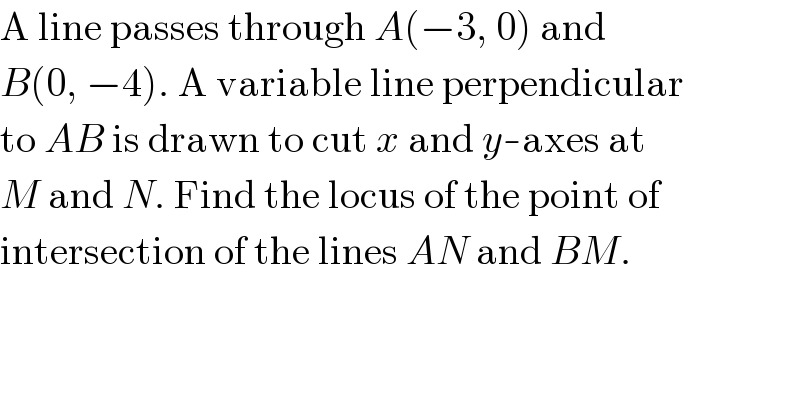
Question Number 25930 by Tinkutara last updated on 16/Dec/17

$$\mathrm{A}\:\mathrm{line}\:\mathrm{passes}\:\mathrm{through}\:{A}\left(−\mathrm{3},\:\mathrm{0}\right)\:\mathrm{and} \\ $$$${B}\left(\mathrm{0},\:−\mathrm{4}\right).\:\mathrm{A}\:\mathrm{variable}\:\mathrm{line}\:\mathrm{perpendicular} \\ $$$$\mathrm{to}\:{AB}\:\mathrm{is}\:\mathrm{drawn}\:\mathrm{to}\:\mathrm{cut}\:{x}\:\mathrm{and}\:{y}-\mathrm{axes}\:\mathrm{at} \\ $$$${M}\:\mathrm{and}\:{N}.\:\mathrm{Find}\:\mathrm{the}\:\mathrm{locus}\:\mathrm{of}\:\mathrm{the}\:\mathrm{point}\:\mathrm{of} \\ $$$$\mathrm{intersection}\:\mathrm{of}\:\mathrm{the}\:\mathrm{lines}\:{AN}\:\mathrm{and}\:{BM}. \\ $$
Answered by ajfour last updated on 16/Dec/17

Answered by ajfour last updated on 16/Dec/17
![let M(a,0) and N(0,b) slope of MN=−(1/(slope of AB)) ⇒ −(b/a)=(3/4) ...(i) slope of AP =slope of AN ⇒ ((k−0)/(h−(−3)))=(b/3) ⇒ (k/(h+3))=(b/3) ....(ii) slope of BP=slope of BM ⇒ ((k−(−4))/(h−0))=(4/a) ⇒ ((k+4)/h)=(4/a) ....(iii) (ii)×(iii) gives: ((k(k+4))/(h(h+3)))=((4b)/(3a)) for locus of P, h→x and k→y ⇒ ((y(y+4))/(x(x+3)))=−1 [using (i)] or x^2 +y^2 +3x+4y=0 .](Q25942.png)
$${let}\:{M}\left({a},\mathrm{0}\right)\:\:{and}\:{N}\left(\mathrm{0},{b}\right) \\ $$$${slope}\:{of}\:{MN}=−\frac{\mathrm{1}}{{slope}\:{of}\:{AB}} \\ $$$$\Rightarrow\:\:\:−\frac{\boldsymbol{{b}}}{\boldsymbol{{a}}}=\frac{\mathrm{3}}{\mathrm{4}}\:\:\:\:\:...\left(\boldsymbol{{i}}\right) \\ $$$${slope}\:{of}\:{AP}\:={slope}\:{of}\:{AN} \\ $$$$\Rightarrow\:\:\:\:\frac{{k}−\mathrm{0}}{{h}−\left(−\mathrm{3}\right)}=\frac{{b}}{\mathrm{3}} \\ $$$$\Rightarrow\:\:\:\frac{\boldsymbol{{k}}}{\boldsymbol{{h}}+\mathrm{3}}=\frac{\boldsymbol{{b}}}{\mathrm{3}}\:\:\:\:\:\:\:....\left(\boldsymbol{{ii}}\right) \\ $$$${slope}\:{of}\:{BP}={slope}\:{of}\:{BM} \\ $$$$\Rightarrow\:\:\:\frac{{k}−\left(−\mathrm{4}\right)}{{h}−\mathrm{0}}=\frac{\mathrm{4}}{{a}} \\ $$$$\Rightarrow\:\:\frac{\boldsymbol{{k}}+\mathrm{4}}{\boldsymbol{{h}}}=\frac{\mathrm{4}}{\boldsymbol{{a}}}\:\:\:\:\:\:....\left(\boldsymbol{{iii}}\right) \\ $$$$\left({ii}\right)×\left({iii}\right)\:{gives}: \\ $$$$\:\:\:\:\frac{{k}\left({k}+\mathrm{4}\right)}{{h}\left({h}+\mathrm{3}\right)}=\frac{\mathrm{4}{b}}{\mathrm{3}{a}} \\ $$$${for}\:{locus}\:{of}\:{P},\:\:\:{h}\rightarrow{x}\:\:\:{and}\:{k}\rightarrow{y} \\ $$$$\:\Rightarrow\:\:\frac{{y}\left({y}+\mathrm{4}\right)}{{x}\left({x}+\mathrm{3}\right)}=−\mathrm{1}\:\:\:\:\:\:\left[{using}\:\left({i}\right)\right] \\ $$$${or}\:\:\:\:\boldsymbol{{x}}^{\mathrm{2}} +\boldsymbol{{y}}^{\mathrm{2}} +\mathrm{3}\boldsymbol{{x}}+\mathrm{4}\boldsymbol{{y}}=\mathrm{0}\:. \\ $$
Commented by Tinkutara last updated on 16/Dec/17
Thank you Sir!
